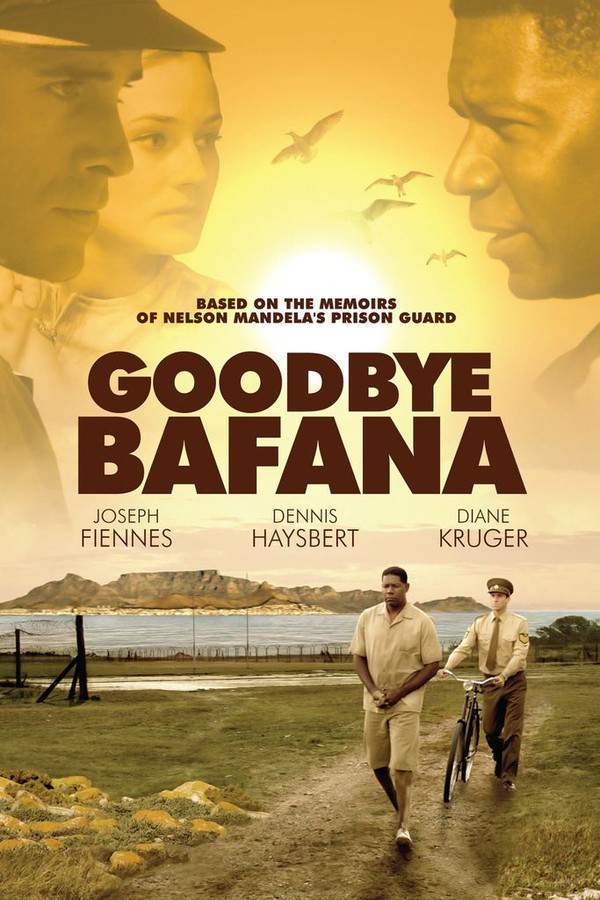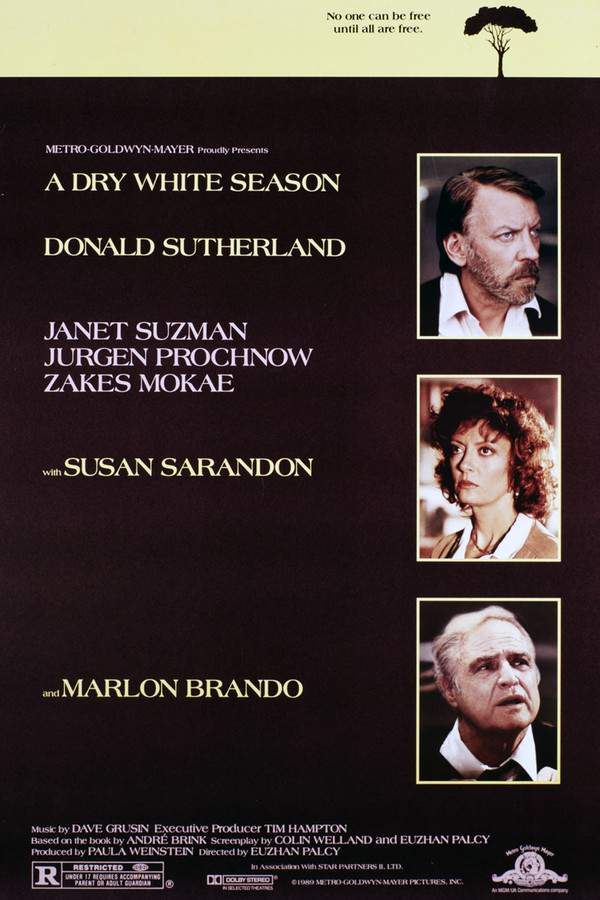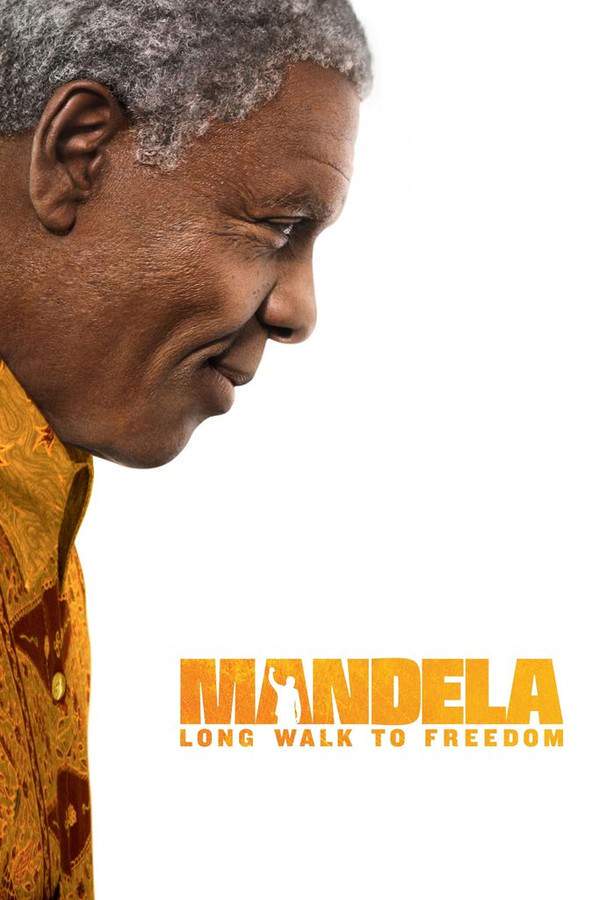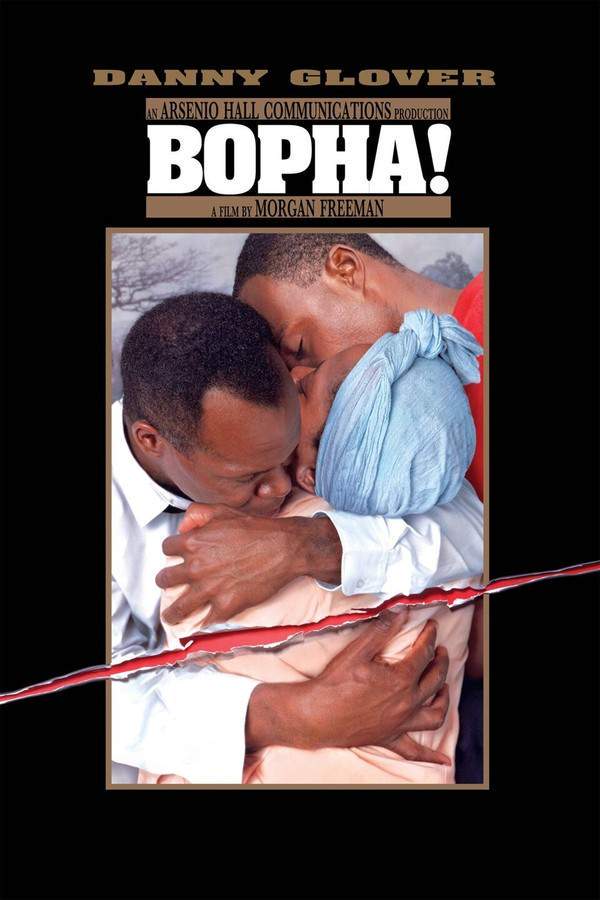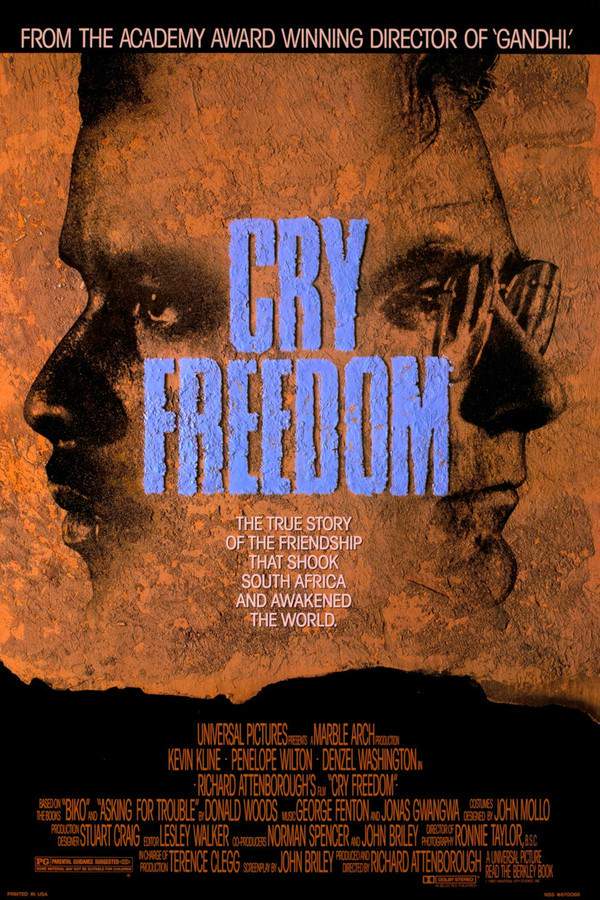
Cry Freedom 1987
Directed by

Richard Attenborough
Made by
Universal Pictures
Test your knowledge of Cry Freedom with our quiz!
Cry Freedom Plot Summary
Read the complete plot summary and ending explained for Cry Freedom (1987). From turning points to emotional moments, uncover what really happened and why it matters.
Following an eye-opening exposé revealing the drastic destruction of a notorious slum in East London, South Africa, liberal journalist Donald Woods becomes fascinated by the challenges faced by anti-apartheid activist Steve Biko. Biko stands as a pivotal figure in the Black Consciousness Movement, and despite their initial ideological differences—Woods strongly opposing Biko’s banning and questioning his political beliefs—he cannot help but be captivated by Biko’s steadfast dedication to nonviolent resistance. Through insightful conversations, Biko invites Woods on an enlightening tour of impoverished black townships, where the harsh realities of government oppression and apartheid’s suffocating presence starkly unfold before them. Witnessing the dire conditions firsthand, Woods starts to understand and share Biko’s vision of a South Africa where every individual, irrespective of race, can enjoy equal rights and opportunities. As their relationship deepens, the two men forge a powerful bond grounded in their united pursuit of justice.
During a pivotal moment, Biko takes his message beyond his limited ‘banning area’ to inspire the masses with a passionate address that resonates with his audience. However, his call for change quickly meets with opposition as he is apprehended by security forces, informed on by an untrustworthy source. After enduring a relentless interrogation, Biko is summoned to court to explain his stance and articulate the burning passion that fuels his movement. Undaunted by an oppressive regime, he eloquently champions the cause of nonviolent resistance, his words infused with unwavering conviction.
In the shadow of this ordeal, Biko’s church comes under siege from security officers seeking to intimidate him. In a courageous move, Woods steps in, securing a meeting with Jimmy Kruger, the South African Minister of Justice, intent on halting the tide of violence and safeguarding his friend. Initially met with resistance, Woods’ grit leads to a fraught confrontation that places him under the chilling threat of harassment, indicating that orders have likely come from Kruger himself.
As Bantu Stephen Biko navigates an increasingly perilous path, he finds himself behind bars in brutal conditions and suffers severe injuries due to a beating, inflicting irreversible damage to his brain. Despite medical advice suggesting he should receive specialized treatment, the authorities refuse due to fears of escape. Instead, they transport him to a police hospital in Pretoria, a grueling 700-mile journey from Cape Town that further deteriorates his fragile condition and results in a tragic outcome.
Following Biko’s heartbreaking death, Woods feels compelled to expose the police’s involvement in this sinister act. However, his efforts face significant obstacles as he is barred from boarding a flight, learning he is banned from leaving South Africa. Consequently, Woods and his family endure relentless harassment from security forces, including gunfire into their home, vandalism, and tormenting packages sent to them, including shirts bearing Biko’s image coated in itching powder.
Unyielding, Woods resolves to find asylum in Britain, motivated by a relentless desire to unveil the heinous and racist nature of the South African government. His journey is fraught with danger as he disguises himself as a priest to escape the grips of the authorities. Ultimately, he manages to reach the Kingdom of Lesotho, where his wife Wendy and their children soon follow.
With the assistance of Australian journalist Bruce Haigh, the British High Commission in Maseru, and the Government of Lesotho, they secure passage with United Nations passports, aided by a lone official from Lesotho. Their daring escape traverses South African territory through Botswana, finally landing them in London, where they are granted political asylum.
The film culminates in a poignant reflection on the harrowing price paid by anti-apartheid activists like Biko, whose lives were tragically cut short while in government custody under dubious circumstances. As the poignant strains of Nkosi Sikelel’ iAfrika echo in the background, viewers are left to contemplate the devastating repercussions of oppression and the indomitable human spirit that fights back defiantly against adversity.
Cry Freedom Timeline
Follow the complete movie timeline of Cry Freedom (1987) with every major event in chronological order. Great for understanding complex plots and story progression.
Donald Woods Discovers Steve Biko
Following an exposé on the destruction of a notorious slum in East London, South Africa, journalist Donald Woods becomes intrigued by the anti-apartheid activist Steve Biko. Their initial interactions reveal a clash of ideologies, yet Woods is drawn to Biko's unwavering commitment to nonviolent resistance.
Tour of Black Townships
Biko invites Woods to witness the dire conditions in impoverished black townships, helping him grasp the harsh realities caused by apartheid. As they explore these communities, Woods starts aligning with Biko’s vision for a more equitable South Africa.
Biko Addresses the Masses
Biko delivers a stirring address outside his banning area, igniting a passionate response from the crowd and calling for social change. This act of bravery, however, leads to immediate backlash from the authorities.
Biko's Arrest
Informed on by an untrustworthy source, Biko is apprehended by security forces following his powerful speech. This marks the beginning of a dangerous struggle as he faces brutal interrogation and is summoned to court.
Biko's Court Speech
Despite the oppressive atmosphere, Biko bravely articulates the need for nonviolent resistance in court. His passionate defense encapsulates the spirit of the anti-apartheid movement, resonating with resilience against the system.
Woods Intervenes on Behalf of Biko
As Biko's church is besieged by security forces, Woods takes a courageous stand by arranging a meeting with Justice Minister Jimmy Kruger. This confrontation highlights the lengths Woods is willing to go to protect his friend.
Biko's Brutal Treatment
While imprisoned, Biko suffers severe injuries during brutal beatings, leading to lasting harm. The authorities refuse to provide necessary medical care, fearing potential escapes, which exacerbates his declining health.
Biko's Tragic Death
Biko tragically succumbs to his injuries while in custody, his death marking a pivotal moment in the anti-apartheid struggle. This event prompts Woods to take decisive action, determined to expose the truth behind the circumstances.
Woods Faces Harassment
In the wake of Biko's death, Woods faces relentless harassment from South African security forces. This includes targeted attacks on his home, serving as a terrifying reminder of the government's oppressive grip.
Escape to Britain
Determined to reveal the truth, Woods devises a plan to seek asylum in Britain. Disguising himself as a priest, he navigates the dangerous path away from South African authorities toward safety.
Journey to Lesotho
Woods successfully flees to Lesotho, where he is eventually reunited with his family. This journey is fraught with challenges and necessitates covert tactics to avoid detection by security forces.
Collaboration with Journalists and Officials
With the help of Australian journalist Bruce Haigh and the British High Commission in Maseru, Woods negotiates his passage out of Africa. Their collaboration underscores international solidarity against oppression.
Successful Asylum in London
Woods finally arrives in London after a treacherous escape that involved traveling through South African and Botswana territories. Once in the UK, he and his family are granted political asylum, marking a new chapter in their lives.
Reflection on Biko's Legacy
The film concludes with a poignant reflection on the sacrifices made by anti-apartheid activists like Biko, whose lives were extinguished in a struggle for justice. Their legacy serves as a call to continue fighting against oppression.
Echoes of Resistance
As the haunting melody of *Nkosi Sikelel' iAfrika* plays, viewers are invited to ponder the ongoing repercussions of apartheid and the tireless spirit of resistance that persists. The final scenes elevate Biko's message, prompting introspection about the human cost of injustice.
Cry Freedom Characters
Explore all characters from Cry Freedom (1987). Get detailed profiles with their roles, arcs, and key relationships explained.
Donald Woods (Kevin Kline)
Donald Woods is a liberal journalist who undergoes a profound transformation throughout the film. Initially skeptical of Steve Biko's methods, he becomes deeply moved by the realities of apartheid and Biko's commitment to nonviolent resistance. Woods' courage and determination to expose injustice drive the narrative forward.
Steve Biko (Denzel Washington)
Steve Biko is a charismatic anti-apartheid activist and leader of the Black Consciousness Movement. His unwavering dedication to achieving equality through nonviolent means makes him a central figure in the struggle against oppression. Biko's courage and eloquence resonate deeply, inspiring others to join his cause.
Wendy Woods (Evelyn Sithole)
Wendy Woods is Donald's supportive wife who faces the dangers of harassment alongside her family. She is depicted as a pillar of strength during tumultuous times, remaining steadfast in her support for her husband’s endeavors. Her character represents the emotional toll on families affected by political unrest.
Jimmy Kruger (John Matshikiza)
Jimmy Kruger serves as the South African Minister of Justice, embodying the oppressive force of the apartheid regime. His character showcases the resistance and threats that activists faced from those in power. Kruger’s interactions with Woods reveal the chilling reality of governmental authority during this era.
Cry Freedom Settings
Learn where and when Cry Freedom (1987) takes place. Explore the film’s settings, era, and how they shape the narrative.
Time period
1970s-1980s
The film takes place during the height of apartheid in South Africa, a period characterized by severe racial discrimination and social injustice. Anti-apartheid movements were gaining momentum, and activists like Steve Biko were advocating for freedom and equality. This era was marked by intense conflict between oppressive governmental forces and those fighting for civil rights.
Location
East London, South Africa, Black townships, Pretoria, Cape Town, Kingdom of Lesotho, Botswana, London
The film is primarily set in East London, South Africa, a city marked by the stark contrasts of apartheid. This backdrop highlights the struggles faced by black townships, where poverty and government oppression are rampant. The journey extends from the brutal conditions in Pretoria to the safety of the Kingdom of Lesotho and ultimately to London, illustrating the stark realities of the oppressive regime.
Cry Freedom Themes
Discover the main themes in Cry Freedom (1987). Analyze the deeper meanings, emotional layers, and social commentary behind the film.
✊
Resistance
The movie portrays a powerful theme of resistance against a brutal regime. Through Steve Biko's nonviolent approach, it sheds light on the struggle for human rights and dignity. His courage to confront oppressive forces inspires others to rise up in the face of adversity.
🤝
Solidarity
Donald Woods' transformation from a skeptical journalist to a passionate ally of Biko emphasizes the theme of solidarity. Despite their differences, their bond grows stronger as they unite for a common cause, showcasing the strength found in partnership and shared ideals.
💔
Tragedy
The tragic outcome of Biko's life illustrates the severe consequences faced by anti-apartheid activists. It highlights the personal toll taken on individuals pursuing justice, leaving a lingering sense of sorrow over the sacrifices made in the struggle for freedom.

Coming soon on iOS and Android
The Plot Explained Mobile App
From blockbusters to hidden gems — dive into movie stories anytime, anywhere. Save your favorites, discover plots faster, and never miss a twist again.
Sign up to be the first to know when we launch. Your email stays private — always.
Cry Freedom Spoiler-Free Summary
Discover the spoiler-free summary of Cry Freedom (1987). Get a concise overview without any spoilers.
In the simmering heat of 1970s South Africa, the rigid laws of apartheid shape every street, every conversation, and the very air people breathe. The country is a mosaic of stark contrasts: bustling urban centers shadowed by sprawling townships, a government that enforces a rigid hierarchy, and a growing undercurrent of resistance that refuses to be silenced. The film’s palette captures both the oppressive glare of official power and the quiet, resilient light that flickers in the lives of those daring to imagine a different future.
Donald Woods is a seasoned journalist whose reputation rests on thoughtful reporting and a clear-eyed view of the world. Working for a liberal newspaper, he is accustomed to probing the headlines while navigating the ever‑present threat of censorship. His curiosity is sparked by an exposé on the demolition of a slum, a story that forces him to look beyond statistics and into the lived reality of the people most affected by the regime’s policies. Woods carries a measured, investigative calm that masks an inner urgency to tell the truth.
Steve Biko emerges as a magnetic figure within the Black Consciousness Movement, embodying a steadfast belief in non‑violent resistance and personal dignity. Charismatic and articulate, he challenges the status quo not with weapons, but with ideas that demand recognition of humanity across racial lines. His visits to the townships reveal a world of hardship that both horrifies and galvanizes him, and his willingness to share that vision draws the attention of those who have never been invited into his sphere.
When Woods and Biko’s paths cross, a tentative alliance forms, rooted in mutual respect and a shared hunger for change. Their conversations become a quiet battlefield where ideas clash and converge, offering a glimpse of hope amid an environment of surveillance and intimidation. The film’s tone balances the oppressive weight of the era with an undercurrent of defiant optimism, inviting viewers to feel the tension of a society on the brink while rooting for the courage of two men determined to expose its deepest contradictions.
Can’t find your movie? Request a summary here.
Movies with Similar Twists and Themes
Uncover films that echo the narrative beats, emotional arcs, or dramatic twists of the one you're exploring. These recommendations are handpicked based on story depth, thematic resonance, and spoiler-worthy moments — perfect for fans who crave more of the same intrigue.
Featured on this page

What's After the Movie?
Not sure whether to stay after the credits? Find out!
Explore Our Movie Platform
New Movie Releases (2025)
Famous Movie Actors
Top Film Production Studios
Movie Plot Summaries & Endings
Major Movie Awards & Winners
Best Concert Films & Music Documentaries
Movie Collections and Curated Lists
© 2025 What's After the Movie. All rights reserved.


